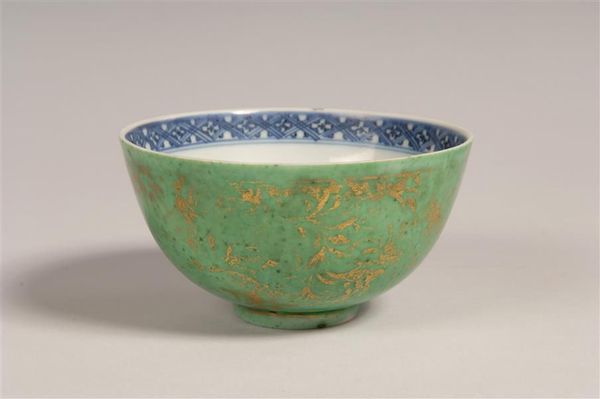Two "Kinrande" bowls from the donation of the Grand Duke of Tuscany, Ferdinando I de 'Medici. China, Ming dynasty, Jiajing era
"Kinrande" bowl from the donation of the Grand Duke of Tuscany, Ferdinando I de 'Medici. China, Ming dynasty (1368 - 1644), Jiajing era (1522 - 1566). Porcelain Collection. PO 3228. Porcelain, painted in underglaze cobalt blue, green glaze; remnants of gold paint visible. H. 6.5 cm, D. 11.8 cm © Staatliche Kunstsammlungen Dresden 2013
"Kinrande" bowl from the donation of the Grand Duke of Tuscany, Ferdinando I de 'Medici. China, Ming dynasty (1368 - 1644), Jiajing era (1522 - 1566). Porcelain Collection. PO 3229. Porcelain, painted in underglaze cobalt blue, iron red glaze; remnants of gold paint visible. H. 6.3 cm, D. 11.7 cm © Staatliche Kunstsammlungen Dresden 2013
Exquisite Chinese porcelain was already more than a hundred years before Augustus the Strong (1670 - 1733) come to Dresden. In 1590 the Grand Duke of Tuscany, Ferdinando I de 'Medici made (1549 to 1609), the Court of Dresden under Christian I of Saxony (1560-1591), a gift of fourteen Chinese porcelains, eight of which have up to now in the obtain Dresden porcelain collection.These include the so-called iron red glazed "kinrande" bowl with remains of a gold painting of lotus blossoms and tendrils. Shells with an over decorated with gold painting emerged in the mid-16th Century and by the Japanese word "kinrande" ("gold brocade") because the decor is reminiscent of Japanese brocade with gold threads. These beautiful shells were particularly appreciated not only in Japan - in 1616 itself, several hundred of those porcelains owned by the Japanese shogun Tokugawa Ieyasu (1543-1616) have been found - but as in Fostat in Cairo, as well as in the distant Spanish colonies Peru and New Mexico enjoyed one of their beauty. In Europe in the 16th Century had "kinrande" mainly because of the lush decoration with gold to the esteemed art collection objects. (From: Giambologna in Dresden, The Dresden gifts of the Medici in 2006, P. 103 - 110.)

/https%3A%2F%2Fprofilepics.canalblog.com%2Fprofilepics%2F1%2F0%2F100183.jpg)
/https%3A%2F%2Fstorage.canalblog.com%2F03%2F02%2F119589%2F96711876_o.jpg)
/https%3A%2F%2Fstorage.canalblog.com%2F11%2F31%2F119589%2F94773502_o.jpg)
/https%3A%2F%2Fstorage.canalblog.com%2F20%2F83%2F119589%2F94772815_o.jpg)
/https%3A%2F%2Fstorage.canalblog.com%2F26%2F72%2F119589%2F75604929_o.jpg)
/https%3A%2F%2Fstorage.canalblog.com%2F59%2F60%2F119589%2F26458628_o.jpg)




/http%3A%2F%2Fstorage.canalblog.com%2F05%2F64%2F119589%2F128523518_o.jpg)
/http%3A%2F%2Fstorage.canalblog.com%2F78%2F46%2F119589%2F127133605_o.jpg)
/http%3A%2F%2Fstorage.canalblog.com%2F99%2F82%2F119589%2F126892955_o.jpg)
/http%3A%2F%2Fstorage.canalblog.com%2F51%2F84%2F119589%2F122518624_o.jpg)